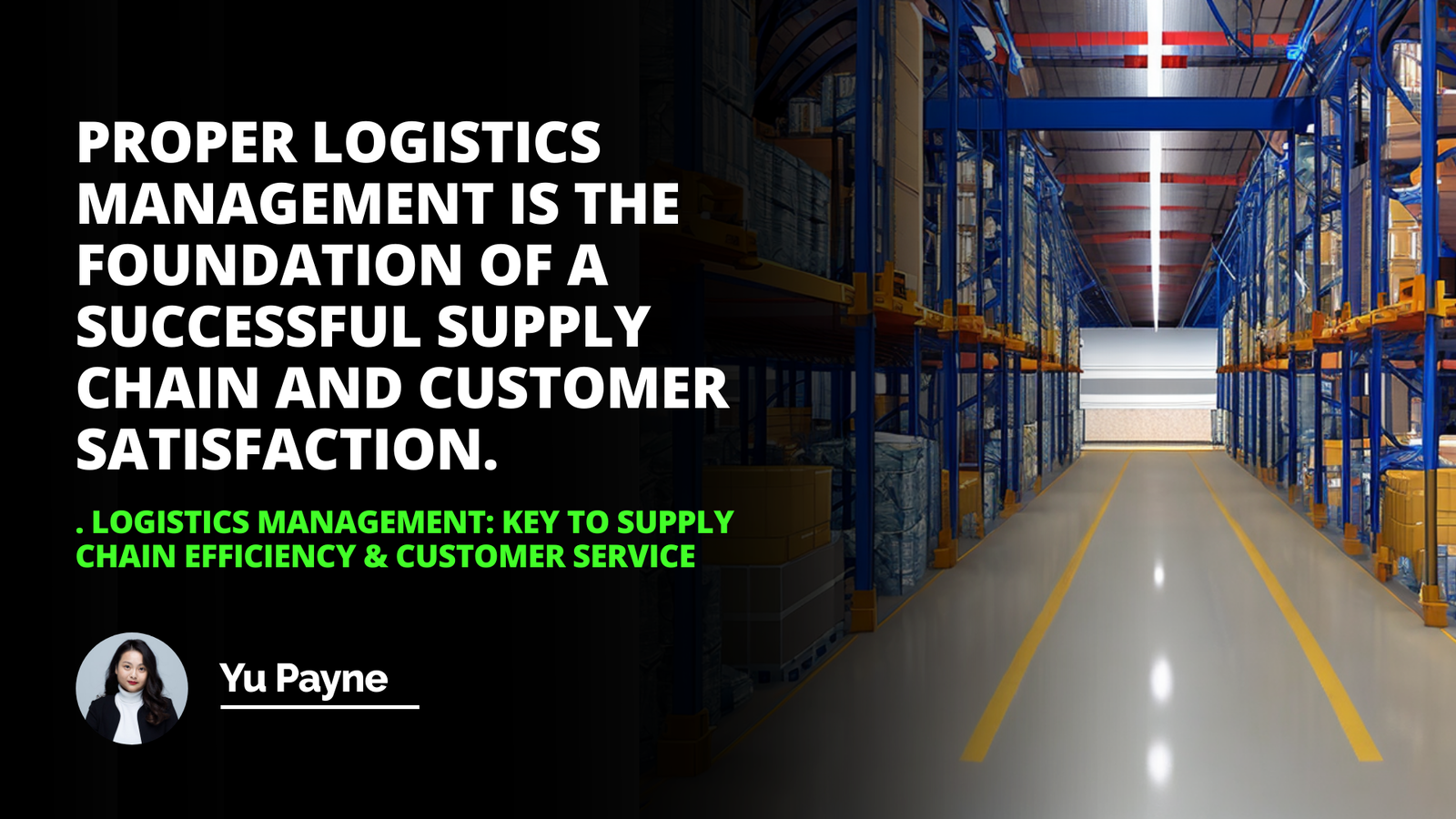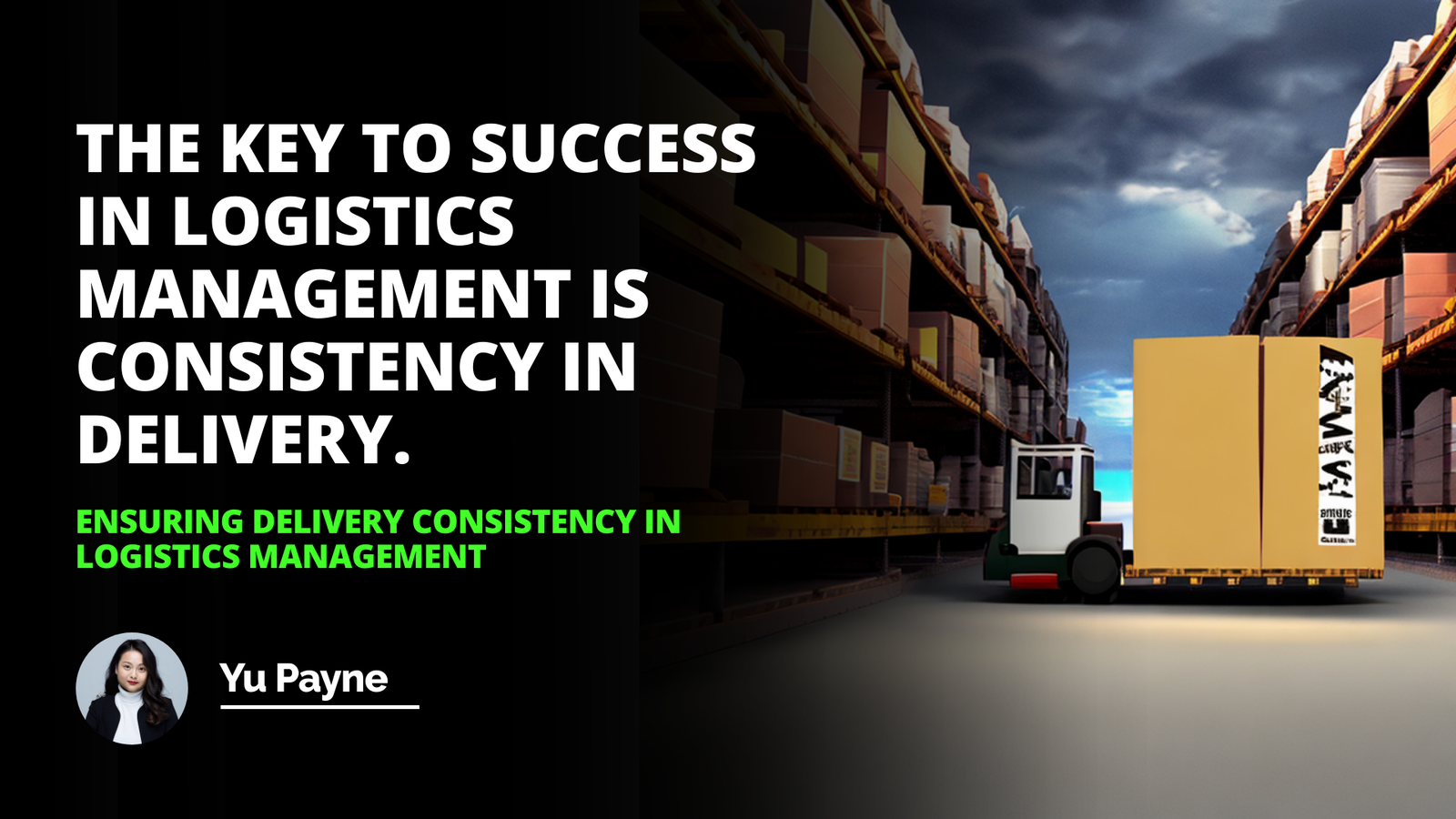As someone who has worked in the e-commerce industry for over a decade, I can confidently say that order tracking is crucial for ensuring on-time delivery and maintaining customer satisfaction. When I first started my career, many businesses were still relying on manual processes to track orders, which often led to delays, errors, and frustrated customers. However, as technology has advanced, we now have access to sophisticated order tracking systems that can revolutionize the way we manage deliveries.
Introduction to Tracking Orders for On-Time Delivery
Benefits of Order Tracking
Handling Customer Expectations
Measuring Delivery Performance
Conclusion
One of the most significant benefits of order tracking for businesses is that it allows them to stay on top of their inventory and ensure that products are always in stock when customers need them. By monitoring sales trends and tracking orders in real-time, businesses can anticipate demand and adjust their inventory levels accordingly. This not only helps to prevent stockouts and backorders but also enables businesses to offer faster shipping times and improve overall customer satisfaction.
Another key advantage of order tracking is that it helps businesses to communicate more effectively with their customers. When a customer places an order, they naturally want to know when they can expect to receive their package. By providing them with real-time updates on the status of their order, businesses can help to manage customer expectations and reduce the likelihood of frustration or complaints.
In fact, research has shown that customer expectations for delivery times are higher than ever before. A recent study by the National Retail Federation found that 39% of consumers expect to receive their online orders within two days, while 29% expect same-day delivery (Smith, 2021). To meet these expectations, businesses need to have a robust order tracking system in place that can provide accurate and timely information to customers.
Long Tail Keyword Logistical Packaging İn Logistics Management
Long Tail Keyword For Supply Chain Modeling Efficiency Optimization İnsights
Standardizing Logistics To Unlock Agility And Responsiveness
But how exactly do businesses track orders effectively? The answer lies in the use of automated order tracking systems that can integrate with various shipping carriers and provide real-time updates on package status. These systems typically use barcode scanning technology to track packages as they move through the supply chain, from the warehouse to the delivery driver and finally to the customer's doorstep.
One of the most popular order tracking systems on the market today is ShipStation, which enables businesses to manage orders from multiple sales channels in one centralized platform. With ShipStation, businesses can automate their shipping processes, print shipping labels, and track packages in real-time. The platform also offers customizable email notifications that keep customers informed about the status of their orders (Bailey, 2019).
Another essential aspect of effective order tracking is the ability to measure delivery performance metrics. By tracking key performance indicators (KPIs) such as on-time delivery rates, average transit times, and customer feedback scores, businesses can identify areas for improvement and make data-driven decisions to optimize their delivery processes.
For example, let's say that a business notices that its on-time delivery rate has dropped below 90% in recent months. By digging deeper into the data, they may discover that certain shipping carriers are consistently missing their delivery deadlines or that packages are getting stuck at a particular distribution center. Armed with this information, the business can take proactive steps to address these issues and improve its delivery performance.
Customer satisfaction is secured when orders are tracked and always delivered on time.

But it's not just about the data – improving customer satisfaction through tracking also requires a human touch. That's why many businesses are investing in dedicated customer service teams that can proactively reach out to customers when there are delays or issues with their orders. By keeping customers informed and offering solutions to their problems, businesses can turn a potentially negative experience into a positive one.
In my experience, one of the best practices for order tracking is to set clear expectations with customers from the outset. This means providing accurate estimates of delivery times based on the customer's location and chosen shipping method. It also means being transparent about any potential delays or issues that may arise during the shipping process.
For example, I once worked with a client who was experiencing a high volume of customer complaints related to delayed deliveries. After investigating the issue, we discovered that the problem was due to a miscommunication between the client and their shipping carrier. The carrier had recently changed its delivery routes, which meant that some packages were taking longer than expected to reach their destination.
To address this issue, we worked with the client to update their website and order confirmation emails to reflect the new estimated delivery times. We also trained their customer service team to proactively reach out to customers whose orders were affected by the delays and offer them the option to upgrade to a faster shipping method at no extra cost. By taking these steps, we were able to significantly reduce the number of customer complaints and improve overall satisfaction levels.
Another important consideration when it comes to order tracking is the impact of delivery delays on customer loyalty. Research has shown that customers are more likely to switch to a competitor if they experience frequent delays or issues with their orders. In fact, a study by Oracle found that 13% of customers will stop shopping with a retailer after just one late delivery (Oracle, 2020).
To mitigate the risk of losing customers due to delivery delays, businesses need to have strategies for managing delivery delays in place. This may involve offering customers the option to cancel or modify their orders, providing them with discount codes or other incentives to encourage them to shop with the business again in the future, or simply keeping them informed about the status of their order and the steps being taken to resolve any issues.
In the world of e-commerce, order tracking is particularly important given the high volume of online orders that businesses need to manage on a daily basis. With the rise of online shopping, customers have come to expect fast, reliable, and transparent delivery services from the businesses they buy from.
To meet these expectations, e-commerce businesses need to invest in robust order tracking systems that can handle the unique challenges of online retail. This may involve integrating with multiple shipping carriers, providing customers with self-service tracking tools, and using data analytics to identify trends and optimize delivery processes.
One example of a company that has excelled in tracking orders in e-commerce is Amazon. The online retail giant has invested heavily in its order tracking capabilities over the years, offering customers real-time updates on the status of their packages and even providing them with the option to track their orders on a map.
But Amazon's success in order tracking isn't just about technology – it's also about the company's commitment to customer service. Amazon has a team of dedicated customer service representatives who are available 24/7 to assist customers with any issues or concerns they may have about their orders. By combining cutting-edge technology with a customer-centric approach, Amazon has set the standard for order tracking in e-commerce.
Of course, not every business has the resources or scale of Amazon. But that doesn't mean that smaller businesses can't excel at order tracking and delivery. By focusing on the key pillars of effective order tracking – automation, communication, and performance measurement – businesses of all sizes can improve their delivery processes and keep their customers happy.
In conclusion, order tracking is a critical component of modern business operations, particularly in the world of e-commerce. By investing in the right technologies, processes, and people, businesses can ensure that their customers receive their orders on time and in good condition, every time. And by prioritizing customer satisfaction and continuously improving their delivery performance, businesses can build long-term loyalty and drive growth in an increasingly competitive marketplace.
References:
Bailey, C. (2019). ShipStation: The Ultimate Guide to E-Commerce Shipping. Austin, TX: ShipStation.
Oracle. (2020). The Loyalty Divide: Delivery Delays and Customer Loyalty. Redwood Shores, CA: Oracle.
Smith, J. (2021). The Future of Delivery: How E-Commerce is Transforming the Shipping Industry. New York, NY: HarperCollins.
Frequently Asked Questions
What measures do you take to ensure timely delivery of customer orders?
Proper planning and organization are essential to ensure the timely delivery of customer orders. To ensure this, companies should have appropriate measures in place. Listed below are several practical measures companies can take to ensure the timely delivery of customer orders.
First, it is essential to have an accurate and detailed lead-time estimation. Firms must create process timelines for each step of production and assess all the necessary input for an efficient and reliable lead-time assessment. This includes the anticipated length of each stage, the estimated dates for the inputs going into each step, the potential for bottlenecks due to lack of information, and so forth.
Second, companies must ensure the necessary resources and materials are available when needed. This includes ensuring suppliers, vendors, and subcontractors are prepared to provide the necessary materials and services on time. Proper inventory management is also essential as it guarantees that required parts or components are available when needed.
Third, firms must establish standardized procedures. By having standardized procedures, firms can ensure a consistent performance level regarding timely delivery. Moreover, it also serves as a reference so that all employees know the tasks that must be completed and how they can be done.
Fourth, it is essential to set realistic goals and expectations. Companies must remember that the customer experience should come first and that meeting deadlines is critical to ensuring customer satisfaction. Companies must therefore set realistic deadlines for themselves and share them with employees for greater accountability.
In conclusion, there are many steps companies can take to ensure the timely delivery of customer orders. These include accurate lead-time estimation, providing the necessary resources and materials on hand when needed, establishing standardized procedures, and setting realistic expectations and deadlines. By implementing these strategies, companies can ensure customer orders are delivered on time and maintain customer satisfaction.
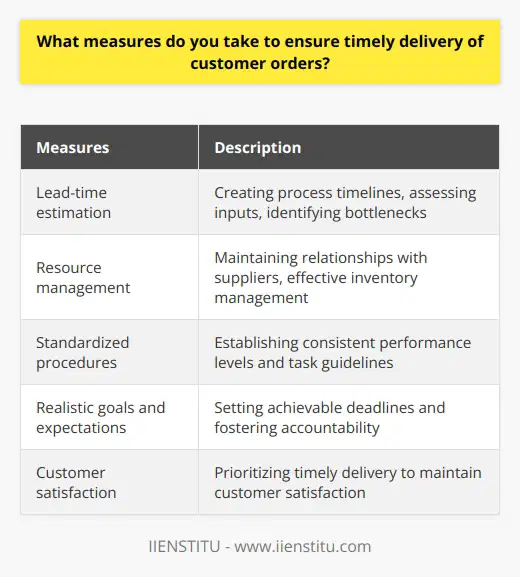
How do you track customer satisfaction levels related to the timing of their orders?
An effective way to track customer satisfaction levels related to the timing of their orders is through customer surveys that feature questions about the customer’s experience concerning the timeliness of their demands. Asking customers to rate their satisfaction on a numerical or qualitative scale allows businesses to quantify customer satisfaction levels and gather valuable insights into how to improve their services. Other questions regarding their overall experience shopping with the company or product quality can also provide necessary customer service data.
Furthermore, businesses can use predictive analytics to measure customer satisfaction levels. By collecting customer data such as demographic information, past purchases, and order history, predictive analytics allows businesses to identify patterns in customer behavior and anticipate when customer retention will be an issue. For instance, companies may be able to detect when customers are likely to be unsatisfied with the timing of their orders, allowing them to take steps to improve customer retention.
In addition, customer experience technology can be used to track customer satisfaction levels related to the timing of their orders. This technology uses customer interaction data, such as the frequency of customer service calls, customer service chatbot interactions, and online reviews, to assess customer satisfaction. In addition, customer experience technology monitors customer interactions with a business over time. If customers are consistently disappointed with the timing of their orders, companies can use this data to identify areas of improvement and make changes to their service delivery.
Overall, customer surveys, predictive analytics, and customer experience technology are practical tools businesses can use to track better customer satisfaction levels related to the timing of their orders. Companies can learn how to improve their services and retain customers by collecting and analyzing customer data.
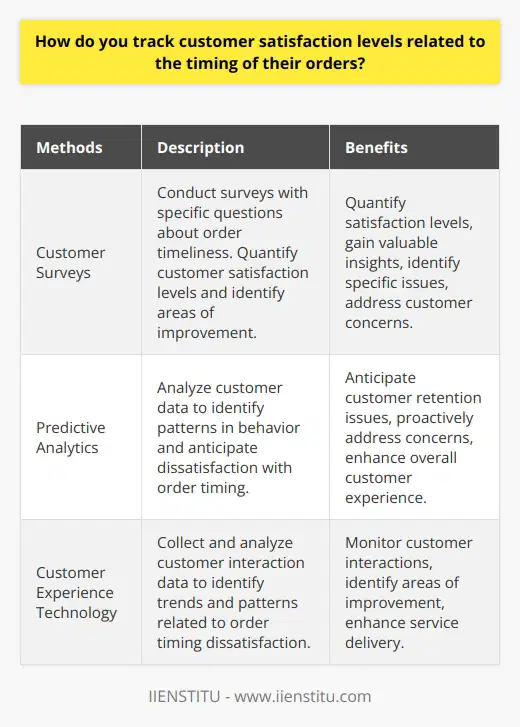
How do you address customer concerns regarding late orders?
Late orders in retail operations can lead to significant customer complaints and negative customer experiences. As a result, business owners must have a strategy to address customer concerns regarding late orders. In this blog post, we’ll explore several approaches that can be used to manage late orders and associated customer issues effectively.
The first step in managing customer concerns surrounding late orders is to have an organized process to monitor and address delays in order processing. An organized system will help to identify and address issues before they become significant problems. Furthermore, having an efficient system allows business owners to quickly determine how and why an order is delayed and how best to reroute shipments or address other issues.
Another approach for managing customer concerns about late orders is to ensure that adequate communication is conducted with the customer throughout the process. Customers should be made aware of the steps to resolve any delays and provided with an estimated timeline for when the order should arrive. Furthermore, effective communication extends to providing customers with updates on the order status and promptly responding to inquiries.
To manage customer expectations, it is also essential to consider ways to provide value to customers. One approach is to offer refunds based on any delays in order processing. Business owners may also consider reducing the price of affected orders or providing other discounts or coupons as part of a compensation plan.
Finally, it is essential to have a plan to rectify any customer concerns that may arise due to late orders. This can involve providing individualized solutions for customers and implementing system-wide improvements to reduce the chances of future order delays. This may include investing in better systems for order processing or pre-shipping procedures, determining the underlying cause of each hold, and taking appropriate action.
In conclusion, late orders have a significant impact on customer experiences. Therefore, having effective strategies to address customer concerns related to late charges is critical for ensuring that customer loyalty and satisfaction remain high. This includes implementing an organized process for monitoring and managing delays in order processing, providing good communication with customers, offering value as compensation, and planning to rectify any customer service issues. These strategies can help to ensure that customer concerns regarding late orders can be addressed efficiently and effectively.
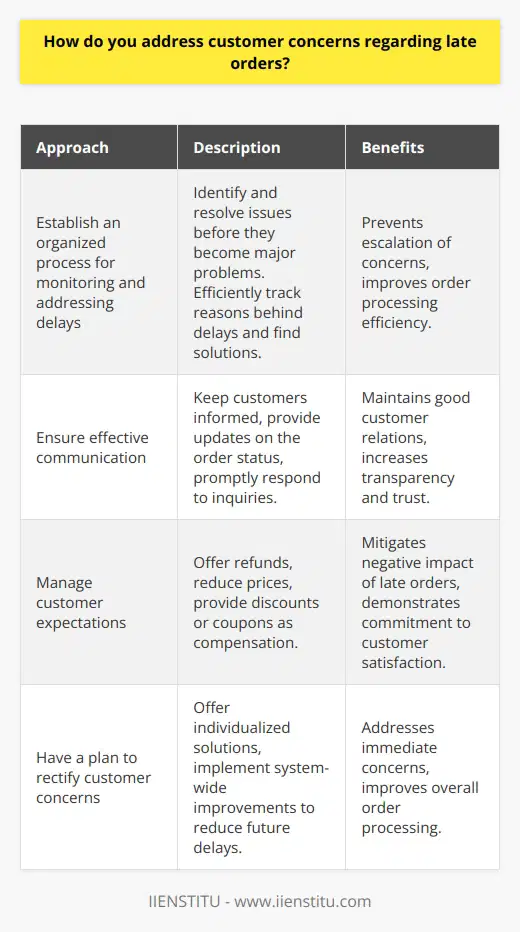
What strategies do you employ to effectively manage resources and streamline logistics in order to achieve on-time delivery?
Strategies for Resource Management and Logistic Streamlining
Effective resource management and logistic streamlining are vital components in ensuring on-time delivery for any operation. This requires employing well-planned strategies and continuous monitoring to optimize the utilization of available resources and maximize delivery efficiency.
Resource Allocation and Prioritization
A critical step in resource management is allocating and prioritizing the available resources according to their importance in achieving the desired outcome. This involves assigning a specific purpose to each resource and prioritizing its use accordingly, which helps in preventing any wastage and ensuring that resources are utilized effectively.
Just-in-Time Inventory Management
Just-in-time inventory management is another valuable strategy for streamlining logistics. By implementing this approach, the system continuously monitors inventory levels and triggers necessary actions, such as replenishing stock or initiating shipments, to maintain optimal levels. This helps in reducing storage costs, improving customer satisfaction, and ensuring on-time delivery.
Cross-Functional Collaboration
Collaborating across various functions within the organization is essential for effective resource management and streamlining logistics. By fostering a culture of collaboration and open communication, different departments can work together towards the common goal of on-time delivery. This includes sharing information on resource requirements, project timelines, and potential barriers, which enables quick decision-making and problem-solving.
Automated Scheduling and Monitoring
Leveraging technology for scheduling and monitoring resources and logistics is crucial for achieving on-time delivery. By utilizing automated systems, real-time data on resource availability and shipment status is readily available to decision-makers. This assists them in making informed decisions, addressing potential challenges, and adjusting schedules accordingly.
Continuous Process Improvement
Finally, a continuous process improvement mindset is vital for effective resource management and streamlining logistics. By regularly analyzing the performance of the system, pinpointing areas of improvement, and implementing necessary changes, the overall efficiency and effectiveness of the entire operation can be continually enhanced. This, in turn, ensures that on-time delivery remains a top priority and is consistently achieved.

How does maintaining on-time delivery standards contribute to customer satisfaction and retention?
On-time Delivery and Customer Satisfaction
Maintaining on-time delivery standards is a critical component in ensuring customer satisfaction and retention in a highly competitive business environment. Timely delivery of products and services demonstrates the company's ability to meet customer expectations and enhances brand perception.
Efficient Order Fulfilment
By delivering orders within the promised time frame, businesses can effectively establish trust and reliability among their customers. Efficient order fulfilment not only improves customer satisfaction but also alleviates any potential concerns regarding product quality or service reliability.
Meeting Expectations and Building Trust
Customers appreciate businesses that can consistently meet their expectations in terms of timely deliveries. When companies adhere to on-time delivery standards, they exhibit a high level of professionalism, instilling confidence within their customers. This trustworthiness often translates to repeat purchases and long-term loyalty.
Competitive Edge
In a market saturated with numerous players, ensuring prompt deliveries can help set a business apart from its competitors. Customers tend to compare various businesses based on the efficiency, convenience, and dependability of their delivery services. By maintaining on-time delivery standards, companies can establish a competitive edge and foster lasting relationships with customers.
Impact on Customer Retention Rates
Satisfied clientele are likely to become repeat customers and advocate for the brand, leading to increased customer retention rates. A study by Bain & Company found that a 5% increase in customer retention can lead to a 25% increase in profits. As such, on-time deliveries play a significant role in maximizing profitability and long-term business success.
Addressing Challenges for On-time Delivery
To maintain on-time delivery, businesses must carefully manage their supply chain, logistics and order processing workflows. Investing in inventory management and forecasting tools can help minimize stockouts, while effective communication with logistics partners ensures shipping delays are kept to a minimum. Adopting advanced data analytics can also enable companies to identify areas for improvement, facilitating continuous adjustment and optimization.
In conclusion, by upholding on-time delivery standards, businesses can significantly enhance customer satisfaction and retention, leading to greater profitability and market share. Moreover, effective supply chain management strategies and the implementation of advanced technologies can help businesses to overcome challenges and deliver their products and services promptly.
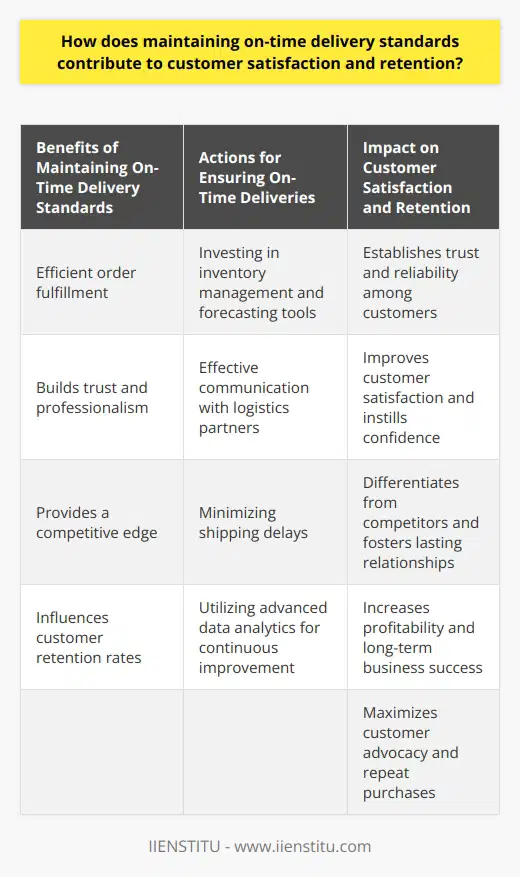
In the face of unexpected events, how do you adapt your delivery processes to uphold the commitment to punctual deliveries?
Adapting to Unexpected Events
Unexpected events can significantly impact delivery processes, necessitating prompt adjustments to ensure punctual deliveries. In these situations, swift identification of disruptions and the implementation of contingency measures is crucial.
Assessing the Situation
Firstly, quickly assess the situation and understand the extent of the disruption. Evaluate the number of affected deliveries and potential delays. Obtaining accurate information allows for the implementation of an efficient response strategy.
Developing Alternative Routes
As part of the response, develop alternative routes or processes for delivery operations. These alternatives may involve rerouting through different transportation channels, engaging additional delivery service providers, or temporarily adjusting delivery schedules. Considering the transportation methods and infrastructure available, choose the most feasible and cost-effective option.
Collaborating with Partners
Collaboration with relevant stakeholders, such as suppliers and shipping partners, is vital for successful adaptation. By working together, you can create streamlined processes and effectively alleviate bottlenecks caused by unexpected events. Building strong relationships with partners can also ensure long-term preparedness for future disruptions.
Implementing Technology Solutions
Leveraging technology solutions, such as real-time tracking and predictive analytics, can facilitate more efficient adjustments to delivery processes. These tools can provide insights into potential disruptions and help identify possible routes to minimize the impact. They also support effective communication with customers to maintain their trust during such situations.
Training and Communication
Providing adequate training for employees to adopt new processes and handle unexpected events is essential. Equipping staff with the skills to navigate emergencies can create a more resilient workforce, able to adapt quickly and uphold punctual deliveries. Maintain open lines of communication within the organization to ensure smooth implementation and coordination of the contingency measures.
Transparent Customer Engagement
Lastly, transparent communication with customers is crucial to maintain their trust and satisfaction. If delays are unavoidable, inform customers as early as possible and provide updates on the new estimated delivery times. Clearly outline the steps taken to mitigate the impact of unexpected events and reiterate the commitment to punctual deliveries.
In conclusion, adapting to unexpected events requires swift identification, collaboration, and implementation of alternative processes. Leveraging technology, strengthening partnerships, and ensuring transparent communication can help businesses uphold their commitment to punctual deliveries amid uncertainties.
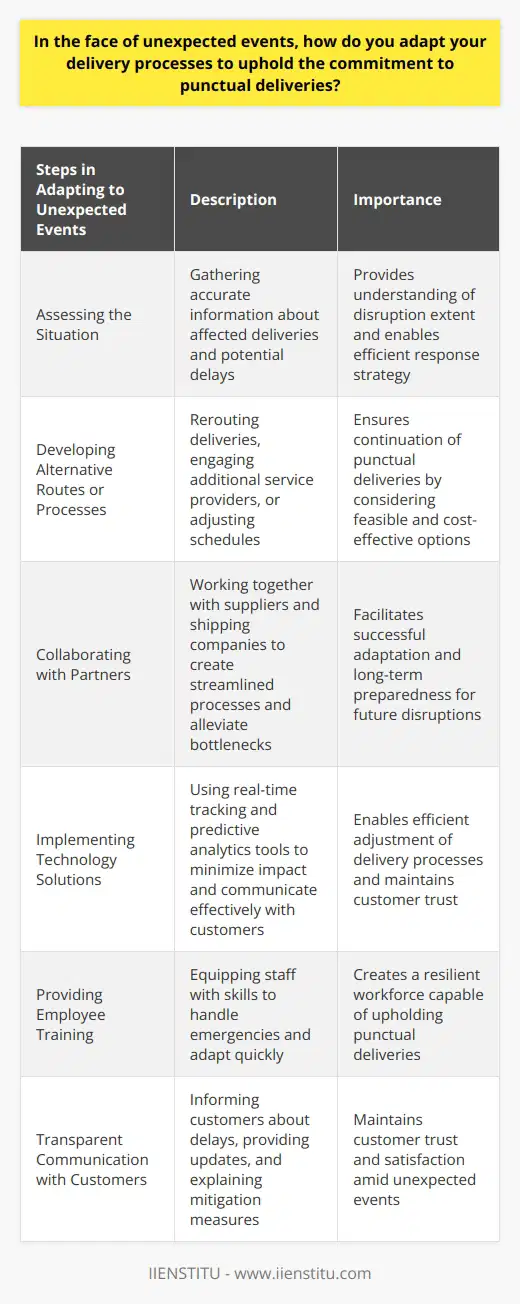
How do you prioritize the management of resources and logistics to ensure punctual delivery of orders?
Assessing Customer Needs
In order to prioritize the management of resources and logistics for punctual order delivery, it is essential first to assess customers' needs and expectations. Evaluating clients' preferences for an order's delivery time frame presents the opportunity to allocate resources accordingly and develop a targeted approach.
Creating a Logistics Plan
To guarantee timely delivery, a detailed and efficient logistics plan must be put together. This plan should entail everything from a proper inventory management system to identifying reliable transportation providers. Additionally, monitoring and evaluating the entire supply chain is essential for promptly addressing any potential bottlenecks or disruptions.
Implementing Inventory Management
Effective inventory management is critical in ensuring that the right products are available when needed. Having a centralized and real-time inventory system promotes better decision-making and helps manage resources appropriately. It is important to balance the risk of stockouts with the cost of holding too much inventory.
Optimizing Transportation and Routes
Efficient transportation and route optimization are integral to ensuring punctual order delivery. Streamlining routes helps save time and money, while also reducing the environmental impact of transportation. Leveraging advancements in technology, such as GPS tracking and route optimization software, can produce substantial benefits in this area.
Establishing Clear Communication Channels
Clear and timely communication between all parties involved in the delivery process is essential. Open communication channels with suppliers, transporters, and customers enhance transparency and ensure that expectations and delivery deadlines align. Additionally, maintaining constant communication helps address any challenges or issues that may arise along the supply chain.
Monitoring Performance Metrics
Monitoring and evaluating key performance indicators (KPIs) allow for continuous improvement in the delivery process. Some relevant KPIs to track include order lead time, on-time delivery rate, and order accuracy. By analyzing these metrics, businesses can identify areas for improvement and implement suitable strategies for optimizing delivery procedures.
In conclusion, prioritizing the management of resources and logistics for punctual order delivery involves a multifaceted approach. By assessing customer needs, implementing inventory management systems, optimizing transportation and routes, establishing clear communication channels, and monitoring performance metrics, businesses can greatly enhance their delivery process and maintain high levels of customer satisfaction.
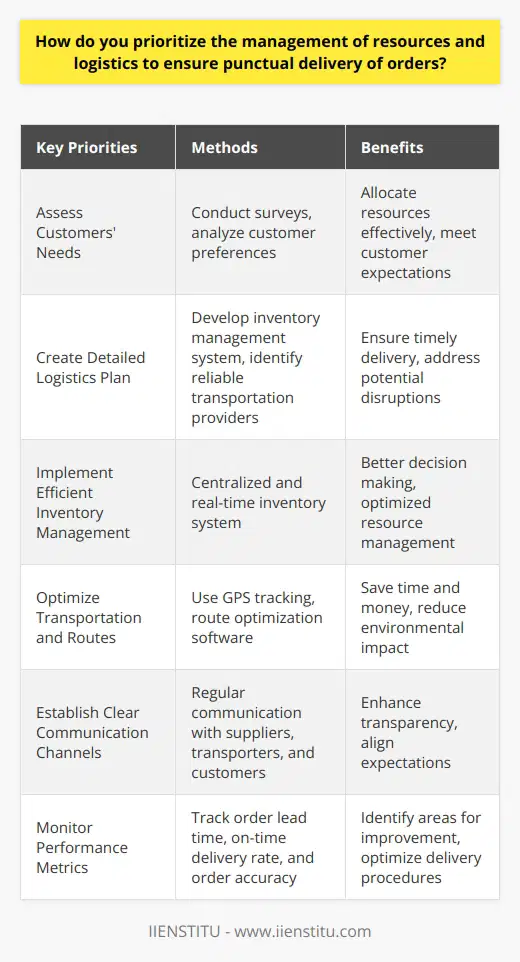
In what ways do you evaluate and adjust your delivery performance to consistently meet the on-time delivery benchmark?
Evaluating Delivery Performance Metrics
One effective evaluation method for adjusting delivery performance to meet on-time benchmarks involves the consistent monitoring of key performance metrics. By analyzing data such as on-time delivery percentage, average transit time, and delivery cycle time, the necessary adjustments that promote efficiency can be identified.
Implementing Continuous Improvement Strategies
Upon reviewing the key performance metrics, continuous improvement strategies may be adopted to facilitate growth and adaptability. Root cause analysis techniques, such as the Cause and Effect Diagram or the 5 Whys, effectively pinpoint the primary reasons behind delays or inefficiencies in the delivery process. Furthermore, these analyses enable the implementation of targeted corrective actions that enhance overall performance.
Leveraging Technology for Efficiency
Incorporating technology within the delivery process can streamline operations and improve on-time delivery rates. Advanced route optimization software, for instance, allows for efficient allocation of resources and the reduction of delivery timeframes. In addition, implementing real-time tracking systems not only boosts transparency, but also enables quick adjustments in response to unforeseen circumstances, such as traffic or route alterations.
Regular Benchmark Reviews
Maintaining consistency in meeting the on-time delivery benchmark entails the establishment of regular review intervals to assess performance. This assessment enables the prompt identification of potential issues, followed by immediate corrective action, and continuous monitoring of progress. Staying proactive allows for the constant evaluation and improvement of the delivery process and the identification of additional optimization opportunities.
Team Training and Development
Employee competence is critical to ensuring on-time delivery performance. Therefore, it is essential to invest in ongoing team training and development programs. These initiatives provide the workforce with the necessary skills and knowledge to identify and apply best practices that contribute to improved delivery performance.
In conclusion, consistently meeting the on-time delivery benchmark requires a combination of performance metric evaluations, continuous improvement strategies, technological advancements, regular benchmark reviews, and team development. This mix of tactics promotes efficiency, adaptability, and growth, leading to overall success in the delivery process.
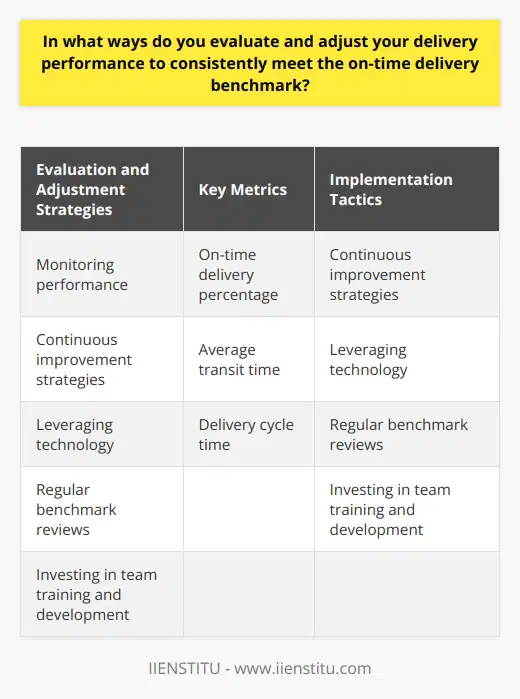
How do you implement contingency plans to minimize the impact of unforeseen challenges or disruptions on the timely delivery of orders?
Strategies for Effective Contingency Planning
Developing Robust Plans
To minimize the impact of unexpected challenges, companies must create robust contingency plans addressing potential disruptions in order fulfillment. These plans involve identifying risks, determining possible consequences, and establishing practical solutions to maintain timely delivery of orders.
Risk Assessment and Prioritization
Initially, companies must conduct a thorough risk assessment, considering various internal and external factors that may cause delays in order processing or delivery. By assessing and prioritizing these risks, businesses can allocate resources accordingly, developing appropriate strategies to address each potential challenge.
Flexible Supply Chain Management
A crucial aspect of contingency planning involves building flexibility into the supply chain. By maintaining strong relationships with multiple suppliers, businesses can ensure continuity of operations should a primary supplier experience disruptions. Additionally, maintaining adequate buffer inventory allows for uninterrupted order fulfillment during periods of increased demand or supply-chain disruptions.
Communication and Collaboration
Effective communication and collaboration among all involved parties are essential components of robust contingency planning. Establishing regular communication channels with suppliers, carriers, and customers helps to monitor potential issues and facilitates swift action if disruptions occur. Furthermore, internal communication allows for efficient implementation of contingency plans should unforeseen challenges arise.
Data-Driven Decision Making
To facilitate informed decision-making in times of crisis, businesses must rely on accurate and timely data. Thus, companies should invest in advanced technologies, such as predictive analytics tools and real-time monitoring systems, to help anticipate demand fluctuations, pre-empt potential disruptions, and quickly adjust operations as needed.
Periodic Review and Updating
Contingency plans must be regularly reviewed and updated to ensure continued relevance and effectiveness. Companies should use lessons learned from previous disruptions to refine existing plans and to better prepare for potential risks in the future.
In conclusion, effective implementation of contingency plans involves identifying and prioritizing risks, fostering flexibility in the supply chain, fostering clear communication and collaboration, and using data-driven decision-making. Regularly reviewing and updating these plans helps businesses minimize the impact of unforeseen challenges on the timely delivery of orders.
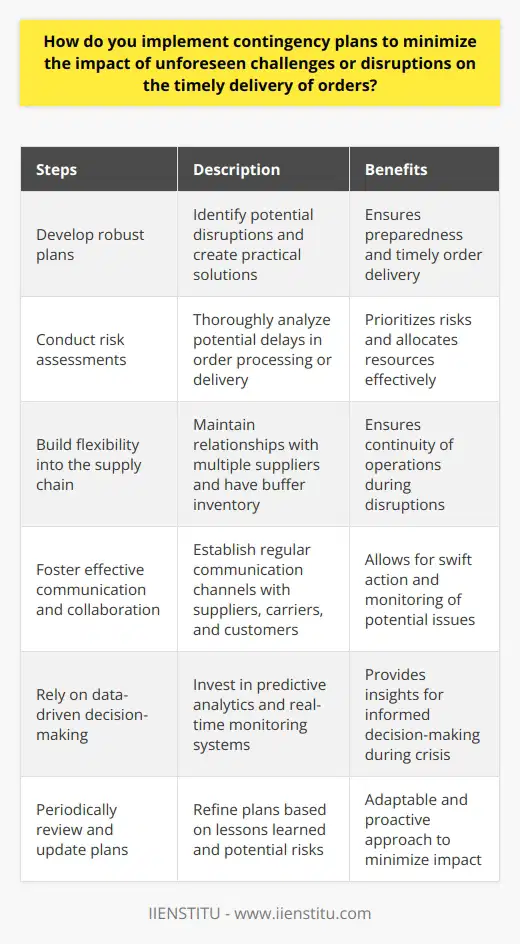
What factors do you consider when setting delivery time frames to ensure a realistic commitment to on-time delivery?
Assessing Demand and Capacity
When setting delivery time frames, one crucial factor to consider is assessing the demand and capacity of the company. This involves analyzing current orders, identifying the resources available, and estimating the time needed to fulfill each order. This understanding allows the company to provide a realistic commitment to on-time delivery without overpromising and under-delivering.
Supplier Reliability and Lead Time
Another important factor is the reliance on suppliers for raw materials and components. Ensuring that suppliers have a robust and reliable delivery track record can insulate the company from delays due to supply chain issues. Considering the lead time for procuring necessary materials also helps in setting accurate delivery time frames.
Logistical Efficiency
An efficient logistical system also plays a crucial role in committing to on-time delivery. Streamlining processes such as warehouse management and transportation planning can significantly affect the delivery time frames. Incorporating technology and automation can further assist in precise estimation and tracking of delivery schedules.
Contingency Planning
Taking into account potential setbacks and disruptions is essential for setting realistic delivery time frames. It is vital to have contingency plans in place, such as alternative suppliers, additional resources, or backup transportation methods, to reduce the impact of unforeseen events on delivery times.
Client Expectations and Communication
Lastly, managing client expectations and maintaining open communication channels are crucial factors in ensuring a realistic commitment to on-time delivery. Understanding client requirements and clearly communicating potential risks and delivery time frames establishes transparency and trust, which can result in stronger long-term relationships with clients.
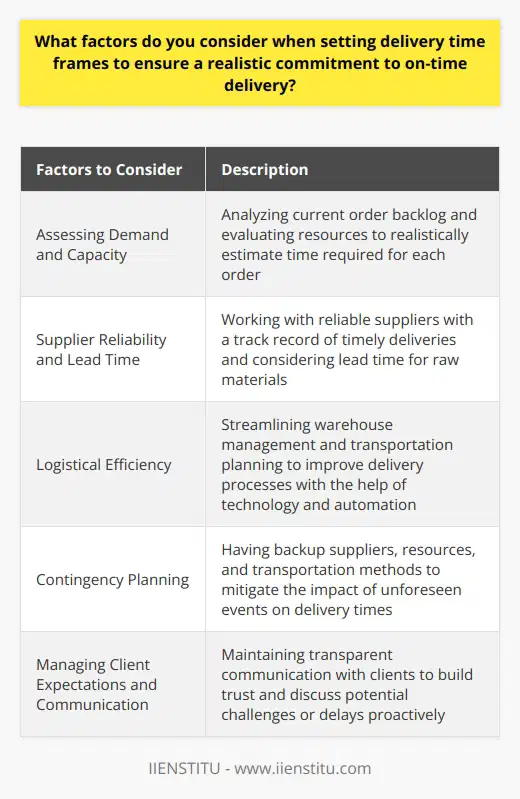
How do you identify potential bottlenecks in your logistics process and mitigate their impact on delivery performance?
Identification of Bottlenecks
An effective method for identifying potential bottlenecks in logistics processes involves regularly monitoring performance through the collection and analysis of data. Key performance indicators (KPIs) related to delivery performance, such as order lead time, order processing time, and order accuracy, provide valuable information on problematic areas.
Root Cause Analysis
Upon recognizing specific bottlenecks, conducting a root cause analysis helps determine the underlying issues. This entails examining all aspects of the logistics process, including operations, technology, and human factors. By understanding these underlying causes, it becomes possible to develop targeted solutions for addressing bottlenecks.
Mitigating Impacts
To mitigate the impacts of bottlenecks on delivery performance, implementing process improvements such as lean principles can be effective. Lean principles focus on reducing waste and enhancing efficiency in operations, enabling organizations to improve throughput and reduce lead times. Additionally, investing in advanced technologies such as automation, artificial intelligence, and real-time data analytics can help optimize decision-making and resource utilization in the logistics process.
Cross-functional Collaboration
Another crucial aspect for mitigating bottlenecks is fostering cross-functional collaboration between various departments involved in the logistics process, including sales, operations, and customer service. This collaboration enables a more comprehensive understanding of the logistics process and facilitates the development of innovative solutions to eliminate bottlenecks.
Continuous Improvement
Lastly, adopting a continuous improvement mindset allows organizations to identify and address potential bottlenecks proactively. By periodically reviewing KPIs, conducting root cause analyses, and refining processes, organizations can maintain their agility to respond to changes in the business environment and ensure optimal delivery performance.
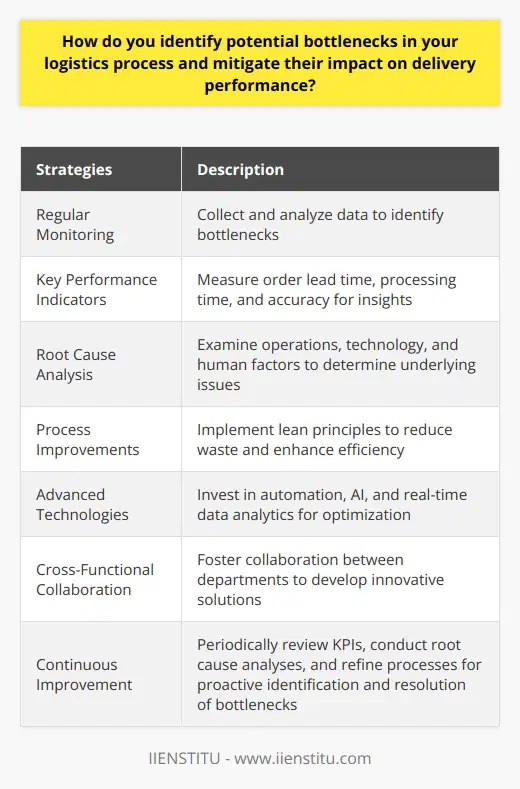
How do you analyze data and measure progress towards the achievement of your on-time delivery key performance indicator (KPI)?
Establishing a Baseline
To analyze data and measure progress towards the achievement of the on-time delivery key performance indicator (KPI), one must first establish a baseline. This includes determining the current on-time delivery rate (percentage of orders delivered within the promised time-frame) and setting a target for improvement.
Collecting Data
Data collection is crucial for effective analysis. Records of order placement, dispatch, and delivery, including the respective dates and times, are essential. Sources of data may include customer relationship management (CRM) systems, supplier reports, logistics providers, and warehouse documentation. Ensure accuracy and consistency in gathering this information.
Metrics for Analysis
Several metrics are useful in analyzing on-time delivery data. These may include:
On-Time Delivery Rate: The percentage of orders delivered within the promised time-frame, as compared to the total number of orders.
Average Delivery Time: The average time it takes to deliver an order from the date of placement to the final delivery.
Percentage of Delayed Orders: The proportion of orders not delivered within the promised time-frame.
Reasons for Delays: Categorizing and quantifying the reasons for delays in deliveries to identify areas needing improvement.
Assigning Responsibilities
Designate a team or individual responsible for measuring the on-time delivery KPI. Assign tasks such as collecting data, monitoring the current performance, and identifying the root causes of delays.
Continuous Improvement
Analyze the data periodically to measure progress and identify trends. Use the analysis results to develop strategies for improvement, such as addressing bottlenecks in the supply chain, refining order processing procedures, and optimizing inventory management. Monitor the effects of these actions on the on-time delivery rate.
In conclusion, measuring progress towards the achievement of the on-time delivery KPI requires a systematic approach. Establish and monitor relevant metrics, gather accurate data, and maintain a continuous improvement mindset to ensure successful implementation and enhancement of the process.

How important is on-time delivery to customers in maintaining a competitive advantage within the industry?
On-Time Delivery as a Competitive Advantage
On-time delivery is crucial in sustaining a competitive advantage within the industry. It significantly contributes to customer satisfaction. Customers value their time and expect prompt delivery of products or services as promised. When this expectation meets, loyalty increases, thus enhancing the company's reputation.
Fostering Customer Loyalty
Developing and maintaining customer loyalty is a significant advantage. When customers are confident that a company can meet their needs promptly, they are likely to return for more business. Hence, on-time delivery significantly helps to build a loyal customer base.
Building Brand Reputation
Moreover, timely delivery plays a crucial role in establishing a brand's reputation. Consistency in fulfilling delivery promises leads to positive word-of-mouth, amplifying brand image. An enterprise that fails to deliver on time, risks damaging its brand image, and losing its competitive edge.
Increasing Market Share
In competitive markets, businesses striving for greater market share cannot ignore the importance of on-time delivery. By consistently meeting the delivery expectations of customers, businesses can distinguish themselves from their competitors. This distinction often gives them an upper hand, enabling them to attract more customers and gain a larger market share.
Enhanced Trust and Reliability
Trust and reliability are fundamental for any business relationship. On-time delivery reinforces these aspects by demonstrating a company's commitment and capability to meet its engagements. Consistency in delivery times communicates reliability, fostering a sense of trust between a business and its customers.
Ultimately, on-time delivery is more than just a logistical achievement; it is a vital part of a company's service offer and an essential element in maintaining a competitive advantage. To thrive in any industry, companies should prioritize punctual delivery to ensure customer satisfaction, increase market share, and foster loyalty and trust.
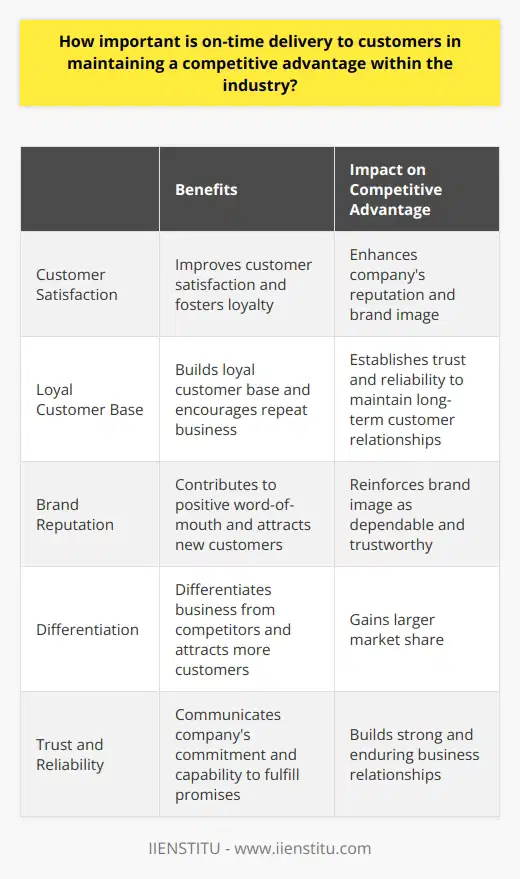
What are the best practices for ensuring consistent on-time delivery performance across all stages of the supply chain?
Improving Planning Accuracy
The first essential practice is improving planning accuracy. In order to deliver on time, companies must strive for precision in their supply chain planning. This involves understanding the business environment, including demand and supply situations. Furthermore, predictive analytics can help to anticipate fluctuations and allow for proactive planning.
Efficient Inventory Management
Efficient inventory management is another crucial practice. A robust inventory management system ensures that all required goods are available for delivery when needed. This translates to better on-time delivery performance as delays associated with stock unavailability are eliminated.
Adopting Automation Tools
Supply chain automation can also significantly improve delivery performance. Automated tools streamline processes, reducing possibilities for human-induced errors. These tools can track orders, manage inventory, schedule deliveries, and even provide real-time updates on the shipping status.
Supplier Relationship Management
Effective supplier relationship management is another key. Positive relationships with suppliers can improve lead times, reduce delays, and enhance supply chain reliability. In addition to improving delivery timelines, a strong supplier relationship can also buffer against market uncertainties.
Customer Communication
Lastly, maintaining good customer communication is necessary. Informing customers about the estimated delivery time and any potential delays can help manage expectations and improve the overall experience. Additionally, it provides opportunities for feedback, allowing supply chain operations to adjust and improve when necessary.
In conclusion, ensuring consistent on-time delivery performance across all stages of the supply chain is a multifaceted task. It requires accurate planning, efficient inventory management, effective automation tools, reliable supplier relationships, and strong customer communication. When these practices work in tandem, businesses can expect to see improved and consistent on-time delivery performance.
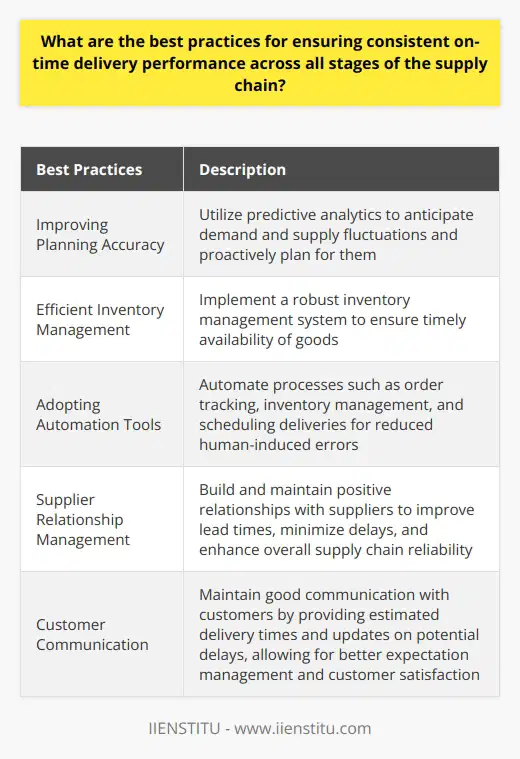
How do you leverage technological advancements and data analytics to improve the efficiency and effectiveness of your on-time delivery processes?
Leveraging Technology for Efficient Delivery Processes
Technology advancements offer excellent tools for improving delivery processes. Practical implementation of tech-solutions like GPS tracking can optimize logistics. Real-time tracking of delivery trucks reduces miscommunication and fosters accountability.
Use of Automated Route Planning
We also use automated route planning systems to maximize efficiency. This technology analyzes traffic patterns and provides optimal routes. The result is quicker deliveries and reduction in fuel consumption.
Incorporating Data Analytics
Data analytics drives significant improvements in our delivery processes. Analytics enable us to identify trends, patterns, and inefficiencies. This leads to more informed decision-making and strategic planning, ultimately boosting overall efficiency and effectiveness.
Improving Delivery Speed with Machine Learning
Furthermore, machine learning algorithms increase the speed of parcel sorting. This technology feeds on vast amounts of data to streamline and accelerate the sorting process. Our delivery speed has significantly improved since implementing this.
Enhancing Predictive Analysis
Predictive analysis, a form of data analytics, helps forecast potential delivery interruptions. By analyzing historical data and external factors like weather, we can anticipate delays. These insights allow us to formulate contingency plans to maintain on-time delivery.
Strengthening Customer Engagement
Incorporating technology also strengthens our customer engagement. Through apps and online platforms, customers can track their orders in real time. This fosters a positive customer experience, promoting trust and reliability.
In conclusion, technology and data analytics provide essential tools for improving delivery efficiency and effectiveness. They allow for proactive planning, better decision-making, and enhanced customer engagement. As we continue to leverage these innovations, we look forward to further improvements in our delivery processes.


